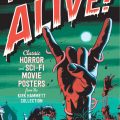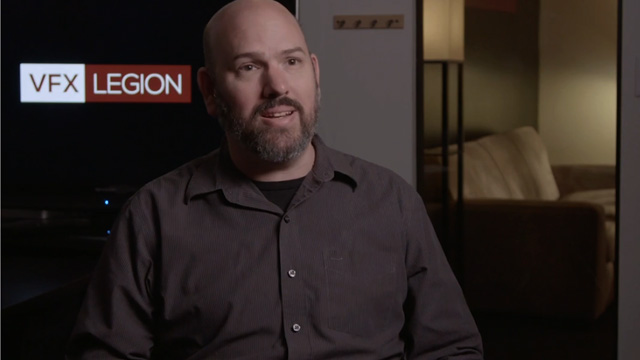
FrightFind recently had the opportunity to interview James Hattin, CEO of the visual effects company VFX Legion. VFX Legion has provided visual effects behind some of the horror industry’s hottest films like Sinister, Insidious 3, and the upcoming Amityville: The Awakening.
FrightFind: First, I want to say I’m a fan of Sinister, Insidious, Amityville. Hardcore Henry, I think we can spend an entire hour talking about Hardcore Henry, just because there’s so much great stuff. FrightFind’s mission is to connect people with all things scary. Some of the work that you guys have done has literally scared the bejeezus out of myself. So tell us a little bit about VFX Legion and your guys’ mission.
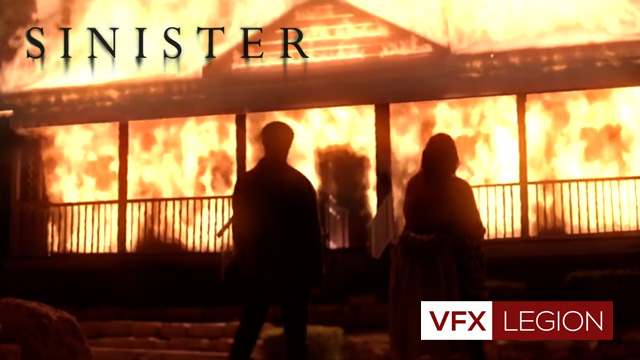
James Hattin: We started the company about four and a half years ago. The idea was we were going to be a remote visual effects facility. So then we could have artists all over the world who maybe termed out, just kind of aged out of the industry, or started a family and didn’t want to have to do the drive in for an hour and a half each way everyday, or move to another country, another city, another state to try and find work. It really became kind of a vagabond lifestyle. You know, you talk about the visual effects Gypsies. A lot of people just… they want to do cool work. They want to work on cool projects.
They don’t really want to have to pick up their whole family and move to Canada or the UK or New York. So we really wanted to take advantage of the technologies that are out there, in terms of being able to do this kind of work remotely, being able to do this at home. Home systems are just as powerful as the systems I worked on in a facility. So now there’s a chance to do that, and we’ve been doing it for the last four and a half years with, I think pretty good success. We’re not giant, but we’ve worked on some really cool things. We keep a steady workflow of projects that we do.
Our mission really is to… I want to say provide the client something that beats their expectations, something that surprises them in a good way, and to help them get their vision through. A lot of directors, a lot of show runners for TV, kind of the equivalent of a director of a movie… they have these ideas, they wrote something in, they envisioned it, and we’re here to facilitate that. We’re here to try and make that happen. So that’s kind of our mission, and that’s our company in a nutshell.
FF: And are you the creative director? Are you in charge of every project that comes in, or how does that work?
James: I am. So as the company founder, I wanted my eye for what I think we should do quality-wise, should be the absolute minimum that we produce, barring a client who wants something that I don’t agree with, but, you know, it’s their money (laughter). But basically, I look at just about everything that goes out, and I sort of direct the creativity. I direct how things look and pitch ideas to clients about how we should address something or how we should achieve a certain look or an effect.
FF: Looking at your portfolio you have a wide array of projects. We naturally gravitate toward the horror and the thriller material. Is there a genre that you work best in?
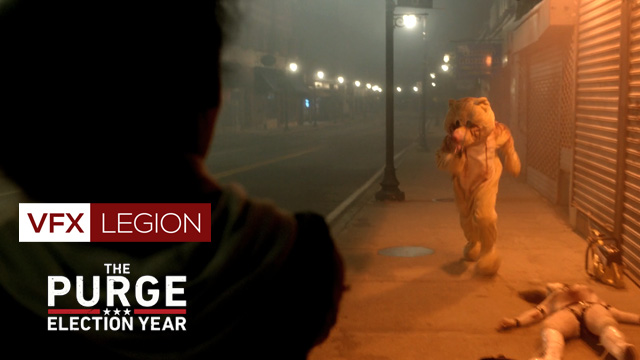
James: Yeah, I would love to say science fiction, but I’ve never actually done much scifi. If you look me up on IMDB, I’ve got like 114 credits to my name. I think the only science fiction that I’ve done is V, the TV series, Falling Skies, the TV series and that’s almost it. I don’t know that there’s something that we gravitate towards particularly. I think you can make anything fun. I think you can make any project interesting and amusing.
FF: I’ve read up on Amityville: The Awakening, sounds like you guys worked on that quite a while ago. The original Amityville Horror was my first horror movie when I was a kid. I had nightmares for years.
James: I have never seen it [Amityville Horror], simply because I didn’t want those nightmares. We did [work on Amityville: The Awakening]. It’s coming out later this year, I think. I don’t think that a lot of our work is going to end up being in the final picture. But there was some pretty disturbing imagery in that show. I think I’m probably bound by a non-disclosure agreement to not really discuss that movie until it’s out. But yeah, there is some… definitely, definitely some creepy, creepy stuff in that movie.
FF: What are you guys working on now?
James: Right now we’re just kicking into our television series, How to Get Away with Murder, Scandal. Some work on Suits, stuff like that. Some independent movies. Nothing that people are going to hear about for a little while.
FF: Is it typical that material you work on takes a year to two years after your work, or is Amityville: The Awakening an outlier?
James:
I think it is [an outlier]. There’s actually two projects that are like that. We have another movie called Stephanie that has aired once at a festival, but by and large has not done a big release, and I think they’re working on the movie again. It’s not super common, but we worked for Blumhouse, which I’m sure you’ve heard about. They’re the producers of some of the better horror movies that have come out over the last decade.
Just the way that they make movies, they make $5 million movies, and if they don’t get a release window or they don’t find the right time to do it, or whomever is distributing for them doesn’t want to distribute the picture, then it’ll sit on the shelf for a while until it gets picked back up and released, sometimes in a smaller format like the movie Incarnate. It was kind of like that where it sort of almost did a direct-to-video sort of thing. Blumhouse has a digital distribution channel for those projects
FF: Gotcha. You mentioned “V” a few minutes ago, and I grew up watching the original.
James: Oh yeah, me too.
FF: What’s a film you’d like to work on? What’s your “white whale?”
James: Oh, unrealistically, I’d love to be in the “Star Wars” universe. I wouldn’t even mind being in the “Star Trek” universe. Yeah, science fiction is the white whale for me.
FF: Do you think you guys have a shot at getting into that universe? Is there a pathway for you guys, or is ILM blocking the way?
James: Yeah. So Industrial Light & Magic is doing most of the Star Wars movies, although they do have side vendors once in a while helping out. With Star Trek, we actually knew some of the people who were working on the Star Trek: Discovery show, but there was just really no chance to jump into that. We don’t have a lot of spaceships on our reel, even though our lead 3-D artist actually worked on the reissue of The Next Generation. He actually has some full shots of the Enterprise that were done in CG that look amazing.
FF: Awesome. So now we’re going to talk some Hardcore Henry.
James: Yeah, sure. Let’s do it.

FF: Watching that film… it was so intense, so fast, so smooth. Half the time, I kept saying, “How the hell…” 30-second rewind. 30-second rewind. Just lay it on me. How challenging was your role in Hardcore Henry, and how did you guys really pull that all together?
James: Yeah, yeah. I got to say, this was like the hardest movie that we’ve ever worked on. It was brought to us by a post supervisor down here named Scott Farrar. He brought it to us very early on, probably a year before we started working on it. He showed us the reels of the movies. We saw I think the first, third, and fourth reel of the movie. Sort of out of context. Movies are done… Just for your information, movies are done in reels still, like they were back when they were cutting film negative. You would have the movie done in reels. Each reel was probably 20 minutes. So you would do as much as you could put on a reel. When they took it to the theater, they would string them all together over one big platter that they would then project. The movies are still, even digitally, broken up into the reel structure.
We got a few of the reels to look at on Hardcore Henry, and one of my partners, Nate and I just at that moment, we were like, “We’ve got to work on this, man.” This is going to be like one of those things that if it doesn’t really hit and go huge, it’s going to be such a unique and groundbreaking thing that we just wanted to be a part of it.
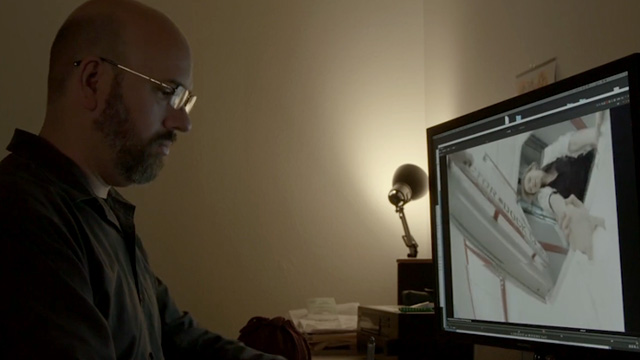
So we jumped in. We saw a lot early. There was obviously stuff that we weren’t really cut out to do. I mean, there was a lot of 3D. A lot of stuff. Yeah, we helped out. We did probably 60-some odd shots. I supervised the whole last reel, the whole fight sequence at the end. I did the quality control and supervising of that. A company called Mighty Coconut down in Austin, Texas. They would do the work, and then they’d feed it to me. I’d take a look at it, give notes back, and then I would pass it along to Ilya, who is the director. After that sequence got done, it actually went to another Russian vendor to add in some more things to it to have it fit Ilya’s vision more closely.
FF: Wow. What were some of the sequences you worked on?
James: The sequences we worked on were some in the control room when Akan first comes in when we first meet him. There’s a whole fight sequence there. It’s where he stabs the guy, who actually is the director of the movie. That’s Ilya getting stabbed. Part of the escape, we worked on, as they get out of the blimp. If you’ve seen our reel when he’s running out … he’s running out and he opens the door and he almost falls out, and he’s just hanging there in space?
That’s one of our shots. We did the blimp and stuff. What else? Then as they land, there’s a [shot] up on a bridge or something, he goes flying off a bridge and lands on the hood of a car. Sneaks around the car shoots a guy. There’s a shootout in a brothel. And lots of little stuff. It’s the stitching things together, it’s the bullet hits, it’s the blood hits. Fixing the makeup on his hand. Yeah, it’s a crazy movie, man. So much.
FF: The whole time, everybody’s just going, “Wait, how did they…?” There was this movie Contact several years ago. Sci-fi, I don’t know if you ever saw it.
James: Oh, yeah! The mirror shot, right?
FF: Exactly. It seemed like there were a thousand mirror shots in “Hardcore Henry” where you’re just like, “I got to figure that out. How did they do that?”
James: Yeah, no. There’s one [scene] where he’s… I haven’t seen the whole movie because it’s too much for me, but there’s the whole scene where he’s sneaking around and he grabs the guy with the pliers in the elevator and he’s shooting some guys, and then he follows the dude out who jumps down the wire. It’s some of our stuff on our Hardcore Henry reel. But there’s this whole shootout. It’s a three-minute scene I want to say. We gave it to one compositor to do the whole thing so that he could get the consistency of it all. Because he had to place all the blood hits, he had to… some guys got shot in the knee, so you had to do the blood coming out of the knee, and then you had to do the blood on the wall. Then you had to make sure that stuck, the blood on the wall, the whole time. So if the camera went back to that spot, you’d still see blood on the wall. It’s all digital. They didn’t shoot any of that in camera.
FF: That’s pretty amazing. What is one of your favorite projects, and if it’s Hardcore Henry, pick a different one.
James: I wouldn’t say that Hardcore Henry was my favorite project. I think it was the most painful project, but with kind of the greatest reward. It’s like gambling. You bet big, you win big. So we’ve kind of walked away with that.
Favorite project, honestly… Another one that hurt while doing it, just because of growing pains and stuff like that which nobody has seen is Jem and the Holograms.
FF: I have daughters, and they, and I, have seen it a few times, yes.
James: Okay, yeah. There’s a ton of visual effects in Jem that are not obvious. The Synergy robot doesn’t have anything on its face, and its ears are not real. Anytime you see it flapping its ears and talking and doing things or chirping, whatever it does, that’s all visual effects, and it’s all really seamlessly done. It’s kind of BB-8 before BB-8 was a thing.
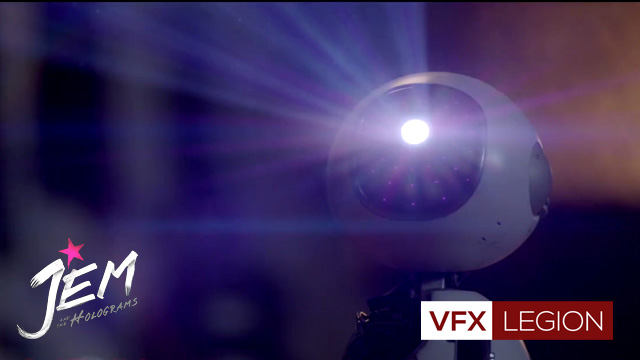
James: Synergy is a puppet. Anytime you see her there’s a puppeteer. There are poles going into it, there’s a puppeteer standing usually in camera. We had to wipe all of that out. So we wipe out the puppeteer rods and we would take out the puppeteer’s legs and put the face on, put the ears on. We worked really closely with the director of that movie. It was a passion project for him, and it was widely panned, simply because it wasn’t the crazy silly thing that Jem and the Holograms was as a cartoon back in the ’80s. I think the blogging community got really upset that it was kind of an origin story, to be honest. It was never meant to be the crazy Jem thing, it was meant to be the lead-in to the crazy Jem thing, so that you didn’t just open a movie with, “She’s a secret agent, surprise!” If you watch the cartoon, it doesn’t make any sense. The writers and the director were very aware of what they were doing and what the original project was, and there was no way to really write into a movie form the ultra-craziness that was Jem the cartoon.
So what they did is they tried to do an origin story, the kind of, “How did she get to where she is? How does she turn into this musical sensation? How does she get to where it’s going to be her battling the bands,” and it’s going to be… The next movie, ostensibly, would have been kind of crazy.
Yeah. That was a fun project. I mean I’ve worked on other projects personally that I’ve had a lot of fun with. But I would say that one was pretty great.
FF: You mentioned earlier that you created VFX Legion to help people work from anywhere in the world. How has technology enabled that?
James: That’s a really solid question. In my mind, it’s more about using the current technologies. The current technologies of even a few years ago. A lot of the protocols, the internet protocols that we use for transferring stuff very quickly had been around since the beginning of the internet, they just weren’t widely used. We’re seeing them being used more and more, because they got the idea of like, “Oh, well if you can do this, then you can do this.” They sort of started making technological leaps within a very old and structured technology. We’ve really benefited from that. We have a very fast internet connection here at the office, and we go out to users who have normal internet connection, so 100 megabit or 300 megabit. We’re really using the technology that’s been out there.
We’re doing what I like to call a “private Cloud.” We’re not getting into the Cloud because I feel like there’s going to be a lot of pitfalls there in the future that just haven’t revealed themselves yet. I’m trying to be forward-thinking and trying to keep this … the idea of our team is all sort of one … it’s like they all work in a building, but the building is a planet. But we’re not using Amazon Web Services or Google or any of that stuff as part of our backbone. We’re connecting directly to the users. Our storage is private, our artists send their material, they send their renders, they send their composites, they send their work directly to our server here in the building. There’s no middleman, there’s no Cloud. Our goal is to keep it private.
FF: What do you say to purists who are kind of anti-CGI and anti-effects?
James: To be honest, I’ve answered this question a couple of times. With respect, I don’t think they know what they’re talking about. One of the problems is… and I totally respect their opinion. What they’re seeing is a lack of money. They’re seeing a lack of attention to detail, but generally, it’s a lack of money. Horror movies do not have huge budgets, and so the idea that CG’s going to be in your horror movie, it’s really hard to do because they’re not funded to do that. I mean, to do a CG creature in a movie is going to cost you $1 million. A horror movie might be done for $3 million or $2 million. Nobody has that kind of budget for visual effects. You simply can’t do it.
So what people are reacting to is the lack of money in the project. I mean, you’ve seen Davy Jones from Pirates of the Caribbean. He’s amazing, and I got to work on the third movie. I mean, he just comes out looking like he belongs in the scene. He looks real. Everything about that character. He’s 100 percent CG, and he looks absolutely real. The visual effects budget for that movie was more than $100 million. It’s not that you can’t do it, it’s that you have to think very differently about how you’re going to approach doing visual effects in a low-budget environment. I think we were really successful with Insidious. The Man Who Can’t Breathe is a real character. The girl who loses her limbs when she’s in The Further? That is CG. We removed her hands and put on nubs onto the ends of her hands and her legs. A lot of the fog on the floor was CG as well, but it’s all CG used in service of the story and not to pull people out, not to do weird things that don’t make any sense just for the sake of doing it.
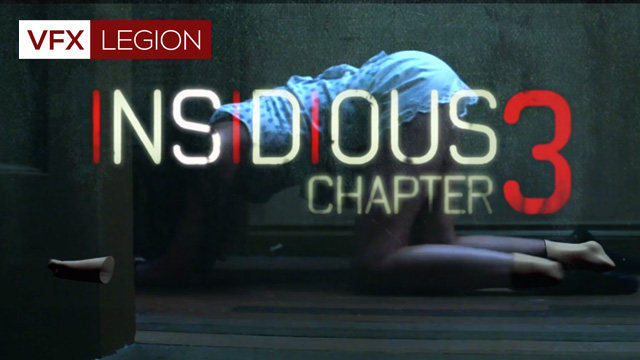
FF: I love the answer and I think when you don’t notice it, that’s when it really makes the most sense to use it. In my opinion. If you notice the effects, then I feel like the CG or the effects have failed. If it doesn’t jar the story it just feels right.
James: Yeah, part of my personal policy and my personal belief is that you can have as much CG in a shot or as much blue screen in a shot, whatever. But my goal in delivering shots out of VFX Legion to the world is they should not bump in the cut. You should not be able to just look at it and be like, “Oh, yeah, that’s fake.” Because I see that all the time. I see that on TV shows. I know things are impossible that I’m looking at, but if they don’t bump, if your brain doesn’t say, “Oh, look. Visual effect.” Then you’ve done a successful thing. You’ve got it out there, and people are just not going to clock that fake thing immediately. They’ll know that the person’s probably not walking 30 stories above the ground on a wire. They’re going to know that that’s not real. Nothing is telling them visually that it’s fake. Does that make sense?
FF: You don’t have to answer this if you don’t want to, but have you ever created something and put it out there and said, “Oh, crap… There’s the bump?”
James: Yeah. A couple of times. I have a couple of great examples. I came from the film world. I used to work on films back in the late ’90s, early 2000s. Most movies were done on film, digital acquisition kind of happened in 2010 and beyond. In the old days of working on films, I’d be looking at a shot on my monitor at a … CRT monitor, not one of these fancy LCD things now. It was just a tube. A monitor. I’d be looking at my shot, I’d be running it, looping it, looking at it, looking for problems to try and fix. Everything would be really sharp and I really wouldn’t like it.
But we would then go and do what’s called “shooting it out”, we’d take the frames that we were working on and we’d put them onto a film recorder and it would basically expose the film with the image that you’d been working on in sequence onto the film. Then you would send that to the lab, get that developed, and then the next day, you’d get it back. What I noticed was that all the little hard lines, the things I thought really pulled me out of the shot, when it got shot to film, everything got softer and nice and organic and it just came together so beautifully. Which is, you know… That’s the great thing about film and that’s when you think you have a stinker and you end up with not a stinker.
The reverse was happening when I first started working on “V” at another company. I was doing shots like that. I was doing the shots to get the edge detail, to get everything. I felt, “These are really sexy,” right? “Then when it gets put on TV, it’s going to be fine. It’s going to look great.” I went home, and because we were working right up against the deadline, so basically when we finished working, three days later, the show was on the air. So there’s really no waiting time. Not like a movie. I went and I watched the episode, and all of my shots looked like … The people looked like they were just cut out. Literally cut out, like sitting on the background. I just thought to myself, “Holy crap, what have I done?”
I expected it to soften up, and they increased the contrast. Everything they did. They dropped the blacks and they popped the brights. They literally just pulled the people off the background. I just … oh, I was mortified. The way the lead artist was working on that show was he would always blur the edges of the people. Just a little bit. Just to squish them in there a little bit. I thought that you don’t do that. Because in film, you don’t do that because when it gets shot out on film, you don’t want it to be blurry and weird. But apparently, in TV, that’s what you do. You take the edge off before it goes on TV, because in the D.I. (color session) they increase the contrast which makes things look separate.
FF: I bet you took the edge off after that one, I would imagine. [PUN!]
James: I started to, yeah. I got a little better at doing that.
FF: A couple more questions for you, and then I’ll let you go enjoy your Friday. It’s almost beer-thirty. I’ve seen some scenes recreated from some of your films in haunted attractions. What of your works would you love to see featured in a haunted house?
 James: Oh, God. You know, I think some of the stuff from Insidious, The Further stuff is really… It’s really potentially creepy. There are a number of sequences in Insidious 3 that we worked on that really would have lent themselves to being in a kind of haunted attraction-type thing. Just seeing people in weird little vignettes in a rainy room, face coming out of the hair kind of thing. It’s just all so demented and honestly scary. The Man Who Can’t Breathe. Man, if you had that sound. If you had like a surround sound, and you had something in a room, and you could just hear the breathing, the labored breathing coming from every angle or multiple angles at different times, that would just freak me the hell out.
James: Oh, God. You know, I think some of the stuff from Insidious, The Further stuff is really… It’s really potentially creepy. There are a number of sequences in Insidious 3 that we worked on that really would have lent themselves to being in a kind of haunted attraction-type thing. Just seeing people in weird little vignettes in a rainy room, face coming out of the hair kind of thing. It’s just all so demented and honestly scary. The Man Who Can’t Breathe. Man, if you had that sound. If you had like a surround sound, and you had something in a room, and you could just hear the breathing, the labored breathing coming from every angle or multiple angles at different times, that would just freak me the hell out.
FF: I know a guy at Sinful Audio that’s going to be loving this interview right now. He creates audio for haunted houses and escape rooms in the Northwest. He lives and breathes this stuff. He will love that idea.
FF: Last question and it’s pretty simple. What candy do you hand out at Halloween?
James: Oh. So, it’s not a complicated answer, but… Historically, my parents always handed out potato chips or Cheetos, or you know, they get the combination boxes of chips. They would hand those out because my parents were sort of against sweets. I’m not a fan of sweets myself, but I married a lovely woman who has a sweet tooth. So we hand out standard … We get like standard candy.
FF: I really appreciate you taking the time today. Is there anything else you wanted to add or say to the audience or get out there about VFX Legion?
James: I don’t know. Just stay scary. Keep being creative and if you’re making things and you’re creating content, especially if it’s horror-based or if it’s authentically scary or you’ve got a story to tell, I would say “do it!” Just get out there and do it. Don’t talk about it. Don’t imagine what it would be like if you could do something that would be cool. I would say get out there and do it. I mean, I started a company well before I felt like I was ready, and I was already in my 40s. I should have done it 20 years ago. So if you’ve got a dream, do it. Don’t just sit around.


